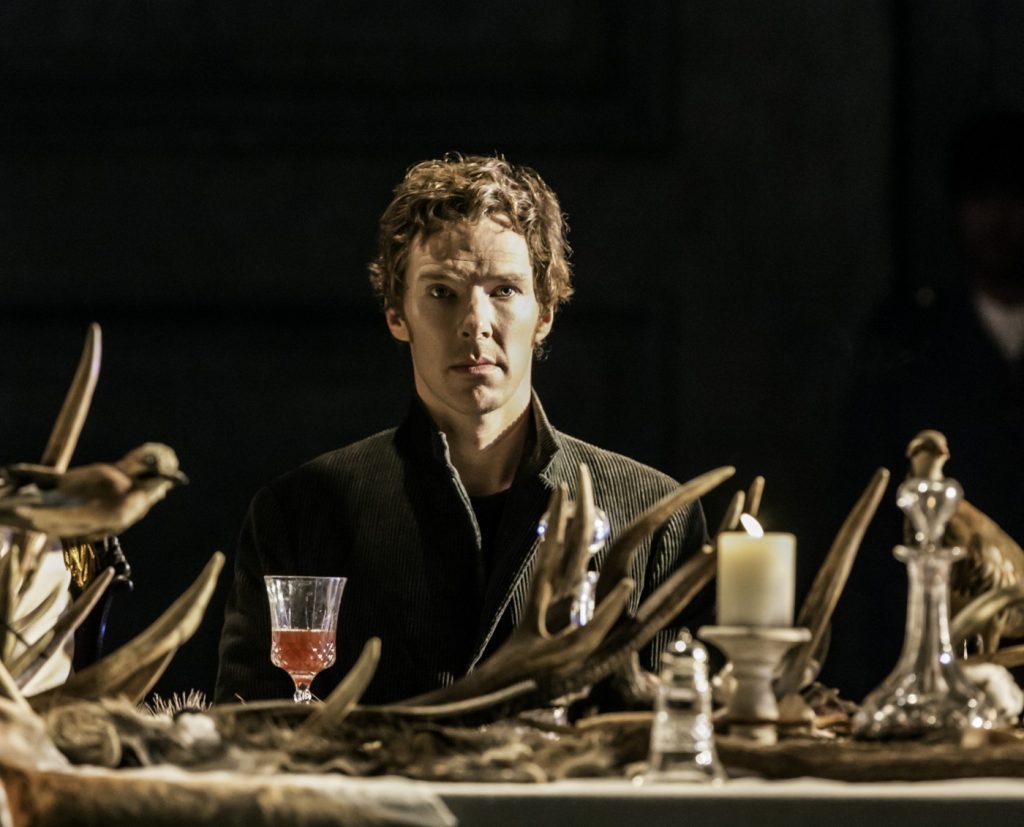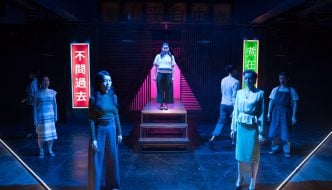
The most hotly anticipated Hamlet adaption returned to the UK’s cinema screens this week with the revival of NT Live: Hamlet (Encore). In doing so, granting unlucky theatre lovers the chance to see the sell-out production, just this time on the big screen.
The stage is lit to reveal the Hamlet we are most acquainted with, the grieving son hidden away in his room, donned in black, tormented by his father’s passing. Sitting alone, staring into space, with Nat King Cole’s ‘Nature Boy’ echoing from a gramophone sat beside him. The wall behind Hamlet lifts to reveal Elsinore in a cinematic widescreen flourish, and the privacy of the small dark room is gone. The set is vast; Hamlet is now stood in a fairy tale-like stately home, military portraits, swords and antiques on the walls. A wedding banquet is laid out in the centre of the room, silver branches decorate the space. However, despite the elegance and luxury of the home, it is cold. Hamlet, now thrown into the room is still a man separated from everything going on around him. This is a key motif in the production; he is often separated from reality, magnifying his solitude.
Benedict Cumberbatch is the undeniable attraction to this production. With tickets selling out almost immediately there were high hopes placed upon the then-39-year-old’s shoulders. Cumberbatch’s Hamlet is a multi-faceted one. This Hamlet may lack the brooding of Daniel Day Lewis’, the vulnerability of Jude Law’s, and the quirky nature of David Tennant’s, but what this Hamlet may lack, he makes up with genuine warmth, shadowed by self-doubt. Cumberbatch leaves his infamous deer stalker at the door and makes the role of Hamlet his own, exposing each and every one of Hamlet’s contradictions with ease. A moment during the first half sees Hamlet wearing several costumes at once: the trainers of a student, the trousers of a soldier, a David Bowie t-shirt and a vandalised tailcoat with the word ‘King’ struck across it. Some have criticised Cumberbatch’s performance, stating that his performance is a ‘collection of characteristics’ rather than a credible character, I’m of the mind that he did an exceptional job of juggling Hamlet’s many intricacies – an exhausting task. Cumberbatch brought relentless energy to his performance and delivered his words with razor sharp precision.
Sian Brooke portrayed the genuinely disturbed Ophelia with spine-tingling frailty whilst Anastasia Hille played Hamlet’s “wretched” mother Gertrude, oblivious to what is going on around her until it is too late. Both gave exceptional performances, particularly Brooke. However, I did feel the female leads became faint presences against the backdrop of such a mammoth production. Karl Johnson, too, is a marvel, doubling as Hamlet’s late father as well as the dry-as-a-bone gravedigger, juggling skulls.
Without a doubt, production designer Es Devlin’s work is a triumph which takes your breath away. The set of the stately home effortlessly transforms into the cold bitter night of the watchmen. A gale-force torrent of debris invades Elsinore at the climax of the first half marking the production’s change in tone. Upon returning from the interval, the grand stately home is cloaked in rubble and ruin, suffocating the furniture and occupants of Elsinore. However, this phenomenal sight and use of effects is no substitute for a thorough narrative and character exploration – something this production falls a little short on. Take for example, the couple Hamlet sets in his sights: Claudius (Ciaran Hinds) and Gertrude (Anastasia Hille). Rather than lustfully clawing at one another the two instead seem remarkably uninterested in each other. The frigidly elegant pair appear together out of convenience as opposed to unadulterated sensuality.
Sadly, the most memorable moments for me are purely visual, which, for a play, is problematic. The moment Ophelia discovers her father’s fate, the house around her darkens and begins to shift, striking music begins to play whilst the daughter howls in horror, being carried away out of sight. Another moment (again delivered by the phenomenal Brooke) sees Ophelia clamber up the rubble to the outside world, the light – and ultimately, her death. Her silhouette looks back, before evaporating from sight. I can’t help but feel this is partly due to the cinematic processes to get this production to the big screen. The camera work is exceptional, framing and amplifying moments which arguably may have been muted into the background of the stage. I can’t help but feel that Lyndsey Turner and Es Devlin may have forgotten a fatal component of theatre – the art of story-telling. Audiences have flocked for centuries to watch characters and their relationships – so if your production’s most memorable moments are purely aesthetic, you have a problem.
Sian Brooke and Benedict Cumberbatch triumph in this production, making the roles their own. However, Lyndsey Turner’s Hamlet elevates visual effects over narrative coherence and character exploration – a fatal flaw for one of Shakespeare’s classics.
Written by Elise Gallagher
Filed under: Theatre & Dance
Tagged with: Benedict Cumberbatch, Hamlet, HOME, HOME Manchester, NT Live, Shakespeare, theatre



Comments